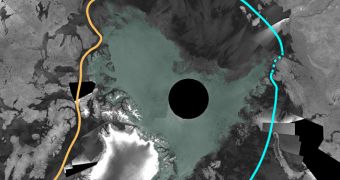This haunted the Europeans for long: a short sea route to China. This is how America was discovered. After that, since the 16th century, various expeditions tried to find a sea route above North America or Siberia to get to China, without the long and painful journey through the Suez or Panama channels (and before by South Africa and southern tip of South America, both dangerous ways because of the windy sea). Now, the link between the Pacific and the Atlantic Oceans could be a reality brought by global warming.
In August, Arctic sea ice decreased to its lowest levels since satellite monitoring started nearly 30 years ago and with this the Northwest Passage has opened up more rapidly than expected.
"We're several decades ahead of schedule right now. The premature opening of the passage does not mean that climate models are unreliable, only that their predictions have been far too conservative," said Mark Serreze, a senior scientist at the University of Colorado's National Snow and Ice Data Center, which monitors the region.
Roald Amundsen crossed for the first time the legendary passage in 1903 to 1906 with great difficulty and employing a relatively small ship. Researchers had forecast the opening of the Northwest Passage from 2012 to 2080 at their most conservative.
"Fully navigable, the Northwest Passage will make the trip 4,000 miles (6,400 km) shorter for ships traveling between Europe and Asia, allowing them to avoid the Panama Canal. The Passage was partially open for a time in 1998, but sailing a ship through at time would have been tricky," Serreze said.
"Through the years, it's become increasingly open, but still really had not remained open in any kind of viable way. 2007 is really the first year. You'd go in through the Bering Strait between Alaska and Siberia, then a little north of Banks Island and then go through the passage." he added.
But the Northwest Passage will not be working a year-round.
"Ice will still be there in the winter, because even in the greenhouse-warmed world, there's winter in the Arctic," Serreze said. But the researchers still remain firm when placing the first ice-free summer Arctic beyond 2050.
"The notion of coming to an ice free Arctic Ocean even by 2030 is not totally unreasonable," said Serreze.
The European Space Agency's Envisat satellite has revealed that from 2006 to 2007, the Arctic ice lowered by about 386,000 square miles (1 million square kilometers).
"The strong reduction in just one year certainly raises flags that the ice (in summer) may disappear much sooner than expected and that we urgently need to understand better the processes involved," said Leif Toudal Pedersen of the Danish National Space Center.
"It could be that natural climate processes are helping to accelerate the effects of global warming. There's a lot of factors that can be involved here." said Serreze.

 14 DAY TRIAL //
14 DAY TRIAL //